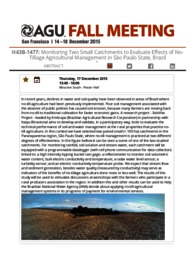Monitoring two small catchments to evaluate effects of no-tillage agricultural management in São Paulo state, Brazil.
Monitoring two small catchments to evaluate effects of no-tillage agricultural management in São Paulo state, Brazil.
Author(s): FIGUEIREDO, R. de O.; GONCALVES, A. O.; MELO, A. da S.; BONA, F. D. de; HERNANI, L. C.
Summary: In recent years, declines in water and soil quality have been observed in areas of Brazil where no-till agriculture had been previously implemented. Poor soil management associated with the absence of public policies has caused soil erosion, because many farmers are moving back from no-till to traditional cultivation for faster economic gains. A research project ? SoloVivo Project - leaded by Embrapa (Brazilian Agricultural Research Corporation) in partnership with Itaipu Binacional aims to develop and validate, in a participatory way, tools to evaluate the technical performance of soil and water management at the rural properties that practice notill agriculture. In this context we have selected two paired small (< 100 ha) catchments in the Paranapanema region, São Paulo State, where no-till management is practiced at two different degrees of effectiveness. In the figure bellow it can be seen a scene of one of the two studied catchments. For monitoring rainfall, soil solution and stream water, each catchment will be equipped with a programmable datalogger (with cell phone communication for data collection) linked to: a high intensity tipping bucket rain gage; a reflectometer to monitor soil volumetric water content, bulk electric conductivity and temperature; a radar water level sensor; a turbidity sensor; and an electric conductivity-temperature probe. We expect that stream flow and sediment generation, besides water quality (measured by conductivity) may serve as indicators of the benefits of no-tillage agriculture done more or less well. The results of this study will be used to stimulate discussions at workshops with the farmers who participate in a rural producers association in the region. In addition this and other results can be used to help the Brazilian National Water Agency (ANA) decide about applying no-till agricultural management systems in its programs of payment for environmental services.
Publication year: 2015
Types of publication: Abstract in annals or event proceedings
Unit: Embrapa Environment
Keywords: Watersheds
Observation
Some of Embrapa's publications are published as ePub files. To read them, use or download one of the following free software options to your computer or mobile device. Android: Google Play Books; IOS: iBooks; Windows and Linux: Calibre.
Access other publications
Access the Agricultural Research Database (BDPA) to consult Embrapa's full library collection and records.
Visit Embrapa Bookstore to purchase books and other publications sold by Embrapa.

